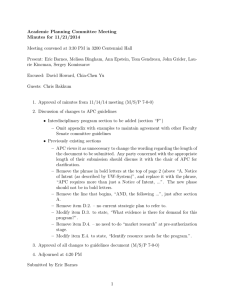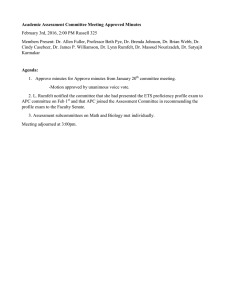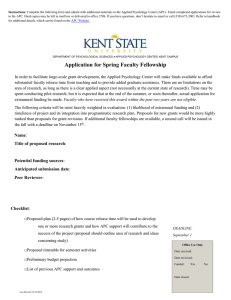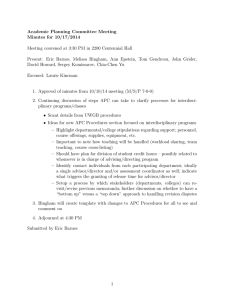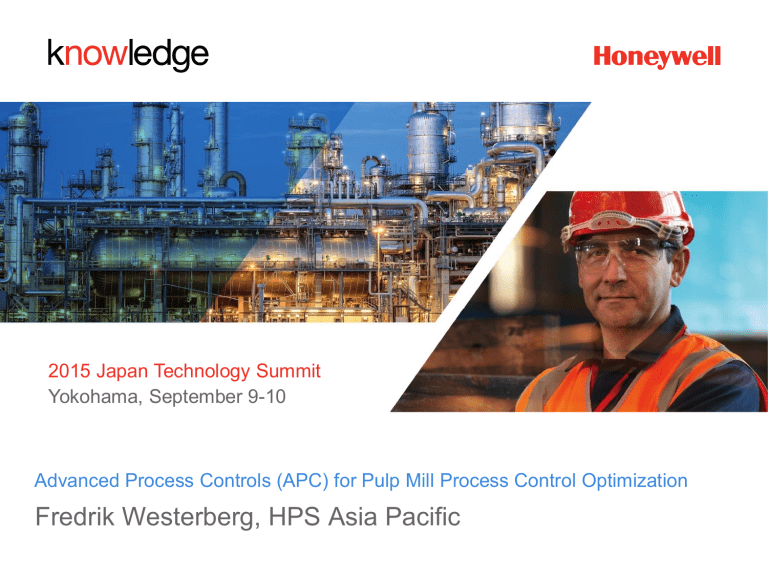
2015 Japan Technology Summit
Yokohama, September 9-10
Advanced Process Controls (APC) for Pulp Mill Process Control Optimization
Fredrik Westerberg, HPS Asia Pacific
Agenda
• Why Advanced Process Control for Pulp Mills?
• What is Advanced Process Control?
• Examples of Successful APC Applications
• Factors for a Successful APC Project
• Return on Investment
2
© 2015 Honeywell International All Rights Reserved
Modern Pulp Mill Challenges
Key Variables in Modern Pulp Process
Production Costs:
Fiber 45%
Chemicals 18%
Kappa Factor
Maintenance / Materials 15%
Fuel & Energy 8%
Basis Weight
Moisture
Brightness
Others 14%
Chemical Residuals
Dilution Factor
Washing Efficiency
BL Carryover
Chip Moisture
Density
White
Liquor
Strength
Residual Carbonate
Temperature Profile
Energy
Organic
Black Load
Liquor Dry Solids
Solids
Combustion
Efficiency
Reduction
Green Liquor TTA
3
Causticizing
Efficiency
White Liquor TTA
Many Measurement, Control,
and
Optimisation
Opportunities!
© 2015 Honeywell
International
All Rights Reserved
Why Consider Advanced Control?
• APC has delivered
benefits in many
industries:
• Typical Pulp Mill benefits
from APC:
Reduced chemical usage
Increased Throughput
e.g. peroxide, caustic, chlorine
dioxide
Improved Yields
Removal of process bottlenecks
Reduced Energy Usage
Decreased Operating Costs
Improved Quality Consistency
Increased Operating Flexibility
Improved Process Stability
Increased pulp production
Reduced energy consumption
Less fuel gas in lime kiln
Less steam in evaporators
Improved Process Stability
Improved pulp quality:
• Brightness
• Kappa
• COD
Lower operator workload
Typical payback period < 6 months
4
© 2015 Honeywell International All Rights Reserved
What does Advanced Process Control do?
$
Max
Profit
Design Limit
Poor Control
Improved Control
Improved Profit by
Changing Targets
APC Improves Process Stability and Pushes the process to the
most profitable operating point
5
© 2015 Honeywell International All Rights Reserved
What is Advanced Process Control?
Multi-Variable Control
Model-Predictive Control
Helps coordinate and decouple
the effects of multiple process
variable interactions
Uses dynamic models to predict
process behavior into the
future. This information is then
used to proactively control the
process
Optimized Control
Integrated optimization
capabilities to drive
applications toward specified
design objectives
6
Constraint Aware Control
Monitors and maintains
Manipulated Variables and
Controlled Variables within
limits while it is controlling the
process
© 2015 Honeywell International All Rights Reserved
The Importance of Optimization
Steam
Chemicals
Pulp
Outputs
Inputs
Chips
Recycle
Save
$ 1.97 / ton
+
Save
$ 0.32 / ton
+
Save
$ 1.97 / ton
+
Save
$ 2.48 / ton
+
Save
$ 0.22 / ton
+
Save
$ 0.62 / ton
=
Save
$ 7.58 / ton
Traditional mindset of optimizing individual unit operations …
7
© 2015 Honeywell International All Rights Reserved
The Importance of Optimization
Raw
Materials
Profits
Outputs
Inputs
Save
$ 1.97 / ton
+
Invest
$ 0.25 / ton
+
Save
$ 4.28 / ton
+
Invest
$ 0.50 / ton
+
Save
$ 6.52 / ton
+
Save
$ 2.28 / ton
Save
$ 14.30 / ton
=
....to a new mindset of optimizing the integrated system
8
© 2015 Honeywell International All Rights Reserved
Profit Suite for Advanced Process Control
Robust MPC
Controller/Optimizer
Robust MPC Modeling &
Analysis
‒ with Expert Rules
‒ Automated on-line modeling
Optimal & Robust
Response
Measurement
(CV)
Manipulation
(MV)
Past
Setpoint
Predicted
Unforced
Response
Control Funnel
Site-Wide MPC
Optimizer
Assumed Values
‒
Optimum
*
FutureRobust Movement
MPC Soft Sensors (Virtual)
‒ without Neural Nets
9
with Dynamic
Optimization
MPC Performance Monitoring
‒ with Loop Performance
Monitoring
© 2015 Honeywell International All Rights Reserved
APC deals with process dynamics and interactions
Stock Flow
Residual
Chlorine
Dioxide Flow
Brightness
Incoming
Kappa
Reaction
Rates
10
© 2015 Honeywell International All Rights Reserved
Profit Controller is based on multi-variable model
MV /
DV
MV01
D0 ClO2
MV02
E1 NaOH
MV03
E1Oxygen
MV04
E1 Peroxide
CV
CV01
D0 Residual
CV02
E1 pH
CV03
CE K
MV = Manipulated Variables (output)
CV = Controlled Variables (input)
DV = Disturbance Variables
All variables are taken together as one system
11
© 2015 Honeywell International All Rights Reserved
DV01
Incoming
Kappa
Using Data to build Process Models
12
© 2015 Honeywell International All Rights Reserved
Pulp Quality Analyzers
Honeywell Advanced Process Control
BTG Unique Quality Sensors
• Kappa Number
• Residual Peroxide
• Bleach Load Dissolved
Lignin, COD
• Residual ClO2
• Brightness
• Consistency
• Freeness
• Color
13
© 2015 Honeywell International All Rights Reserved
How is APC applied in Pulp Mills?
Bleach APC
Delignification
APC
Mech Pulping APC
Washing APC
Digester APC
Evaporator
APC
14
Lime Kiln APC
Recovery
Boiler APC
© 2015 Honeywell International All Rights Reserved
Causticising
APC
Why implement APC on Continuous Digesters?
Set Point
Gauss diagram
Number of samples
Shift set point= increased
yield and avoid low strength
pulp
400
350
1 kappa = 0,4% production
300
250
Before control
Low Viscosity
200
After control
Low Brightness
150
100
50
0
15
16
17
18
19
20
21
22
23
24
25
26
27
Kappa out from digester
15
© 2015 Honeywell International All Rights Reserved
Continuous Digester APC - Typical Design
MV4
CV5
CV1
MV1
CV4
MV8
CV6
MV5
CV2
MV2
CV7
CV3
MV7
CV9
CV8
MV3
BTG SPK-5500
16
Controlled Variables
CV
Manipulated Variables
MV
Chip Bin Level
CV1
Chip yard actuators
MV1
Production Rate
CV2
Chip Meter
MV2
Alkali-to-Wood
CV3
White Liquor flow(s)
MV3
Residual Alkali
CV4
Cooking Temperature(s)
MV4
Digester Chip Level
CV5
Extraction Flow
MV5
Extraction ratio
CV6
Counter Wash Flow
MV6
Dilution factor
CV7
Blow Flow
MV7
Blow Consistency - Outlet DP / load
CV8
Recirculation flows
MV8
K/Kappa Number
CV9
© 2015 Honeywell International All Rights Reserved
Achieved Benefits from Advanced Control
Benefits
Digesters APC Solution
K1
Dig
Criteria
#1
Kappa variability
reduction
#2
Units
Target
value
Achieved
value
K2
Dig
Criteria
% COV
25
32,9
#1
Kappa variability
reduction
Throughput
improvement
TPD
4,0
7,3
#2
#3
Alkali Usage
reduction
Liquor /
ton of
drywood
0,75 %
7,42 %
#4
Black liquor
solids increase
%
0,2 %
0,1%
17
Units
Target
value
Achieved
value
% COV
25
26,5
Throughput
improvement
TPD
7,3
7,5
#3
Alkali Usage
reduction
Liquor /
ton of
drywood
2,0 %
8,7 %
#4
Black liquor
solids increase
%
0,6 %
1,0%
© 2015 Honeywell International All Rights Reserved
$$
BL
Solids
Dil.
Factor
Soda Loss
COD
Optimal Dilution Factor
$$
Relative cost per ton pulp
Why implement APC on Washers?
80
Total Operating Cost
70
60
Evaporation Cost
50
40
30
20
Cooking Chemical Losses
10
Bleaching Chemical Costs
0
1
2
3
4
5
6
Dilution factor ton/ton pulp
Optimize the washer load distribution and water balance
•
•
•
•
18
Maximum solids in weak liquor (Minimal H2O must be evaporated)
Minimal discharge to sewer (Close the water loop – meet and keep
environmental permits)
Minimal carryover of spent cooking liquor and dissolved lignin in pulp
(minimal “soda loss”, bleaching chemical savings)
Minimal use of hot process wash water (energy savings)
© 2015 Honeywell International All Rights Reserved
Washing APC – Typical Design
CV3
MV2
MV1
MV1
Clean
Water In
CV1
CV2
CV2
Stock from
Blowtank
CV5
Stock to
HD
CV2
Weak Liquor
To Evaps
MV3
CV6
CV6
DLT-5500
CV6
CV4
19
Controlled Variables
CV
Manipulated Variables
MV
COD (DLT transmitter)
CV1
Wash Water Feed to the Washers
(Dilution Factor)
MV1
Washer Levels (Drum Washers)
CV2
Fresh Water Make up
MV2
Dilution Factor
CV3
Dilution Water
(Consistency Control)
MV3
Weak Liquor solids concentration
CV4
Brown Stock Feed Consistency
CV5
Dilution water tank/other tank levels
CV6
© 2015 Honeywell International All Rights Reserved
Achieved Benefits from Advanced Control
Simpson Tacoma Benefits
Washing APC Solution
• What the customer told us:
– Reduced Chemiwasher water
consumption by 10%
– Resulted in $500K/year energy savings
in evaporators
– “APC now makes most of the critical control
changes that were once relegated to
human operators”
– Freed up operators to focus on other
activities
Savings estimated to be $2.00/ADT
20
© 2015 Honeywell International All Rights Reserved
Why implement APC on Delignification & Bleaching?
“Spreading the Bleaching Load” through the use of Advanced
Process Controls
Lignin versus brightness profile optimization
KAPPA
after
COOKING
Benefits:
• Increased Throughput
• Improved Yields
• Decreased Operating Costs
• Improved Quality Consistency
• Improved Operating Flexibility
• Improved Process Stability
Final
Brightness
KAPPA REDUCTION
60 %
KAPPA FEED FORWARD AND
FEEDBACK CORRECTION
KAPPA REDUCTION
50 %
KAPPA FEED FOR/WARD AND
BRIGHTNESS FEEDBACK
CORRECTION
BRIGHTNESS
after
COOKING
O2-DELIGN.
21
BRIGHTNESS FEED FORWARD
AND/OR FEEDBACK
CORRECTION
Bleached Pulp
Kappa
1-STAGE
© 2015 Honeywell International All Rights Reserved
2-STAGE
3-STAGE
4-STAGE
O2 Delignification APC – Typical Design
O2
CV2
STEAM
O2
Reactor
O2
Reactor
SPK-5500
MV1
CV5
O2
Blow
CV1
CV4
DV1
DV2
Rct #2 O2 Mxr
pH
DV3
Oxidized
WL
CV5
CV3
MV2
SPK-5500
O2 Delignification
MV
22
CV
CV
DV
Caustic, NaOH applied first O2 stage
Ph after first O2 tower
Production rate to O2 delignification
Oxygen applied to first O2 stage
Kappa after first O2 reactor
Incoming Kappa (SPK)
LP steam to first reactor
O2 reactor temperature 1
Incoming Bleach Load (BLT)
Caustic, NaOH applied second O2 stage
Ph after second O2 tower
Oxygen applied to second O2 stage
Kappa to D0 stage
LP steam to second reactor
O2 reactor temperature 1
© 2015 Honeywell International All Rights Reserved
Bleaching plant Delignification APC – Typical Design
H2O2
NaOH
O2
Residual
Peroxide
MV4
ClO2
MV3
MV2
EOP
D0
CV5
MV1
CV3
CV2
pH
pH
DV1
DV2
pH
CV6
CV1
RT-5500
BLT-5500
CV4
BLT-5500
D0 – EOP Stages - Delignification
MV
CV
CV
DV
DV
ClO2 applied to D0 stage
ClO2 residual to D0 tower
Incoming Bleach Load (DLT)
Oxygen applied to EOP stage
pH to D0 tower
Incoming Kappa (SPK)
H2O2 applied to EOP stage
CEK Kappa after extraction
Caustic, NaOH applied to EOP stage
CEK Brightness after extraction
H2O2 residual
Ph after EOP tower
23
© 2015 Honeywell International All Rights Reserved
CV3
Bleaching plant Brightening APC
NaOH
ClO2
CV6
ClO2
MV2
CV1
D2
E2
D1
MV1
BT-5500
MV1
CV3
From EOP
DV1
DV2
pH
CEK
Brightness
CV4
CV2
BT-5500
CV5
BLT-5500
D1 – E2 – D2 stages - Brightening
MV
CV
DV
ClO2 applied to D1 stage
Final Brightness from D2 stage
Incoming CEK Kappa / Brightness
(BT/SPK in EOP stage)
NaOH applied to E2 stage
Brightness from D1 stage
Production rate
ClO2 applied to D2 stage
pH before E2 stage
pH after E2 stage
ClO2 residual before D2 tower
Final Brightness from Laboratory
24
© 2015 Honeywell International All Rights Reserved
Achieved Benefits from Advanced Control
SAPPI Cloquet, MN Benefits
Bleach Plant APC Solution
Benefits
• Reduced sodium hydroxide usage by
6.8% for Birch
• Reduced chlorine dioxide usage by
7.3% for Birch
• Reduced sodium hydroxide usage by
13.0% for Pine
• Reduced chlorine dioxide usage by
10.5% for Pine
25
© 2015 Honeywell International All Rights Reserved
Mill-Wide Advanced Process Control
Optimization
Bleach APC
Delignification
APC
Washing APC
Digester APC
Lime Kiln APC
Recovery
Boiler APC
Evaporator
APC
26
© 2015 Honeywell International All Rights Reserved
Causticising
APC
Factors for APC success
• Economic justification at the outset
• Management support (‘buy-in’)
• Good implementation – technology, scope,
expertise
• Ownership by site personnel (‘acceptance’)
• Ongoing maintenance and support policy
• Good regulatory performance (valves, tuning,
instruments)
• APC ‘champion’ in the organisation – focal point
for continuous improvement
• Appropriate training of key personnel
27
© 2015 Honeywell International All Rights Reserved
Estimated Mill Wide Savings from APC
APC Solution
Typical $ return /
Production Ton /
Year
Estimated
APC Cost
excl FI
Digester - Continuous
$ 1.50 - 2.50
$220-300k
Production increase 1-3%, Pulp Quality, Bleaching
Cost
O2 Delignification
$ 0.50 – 2.50
$ 80-120k
Environmental, Bleaching Cost, Helps de-bottleneck
the evaporators
Brownstock Washing
$ 0.50 - 2.50
$ 90-150k
Environmental, Bleaching Cost, Pulp Quality
ClO2 Generation
$ 0.30 – 2.00
$ 100-150k
Product Quality, Productivity
Bleach Plant
$ 1.50 - 3.50
$ 150–300k
Bleach Cost, Pulp brightness, Productivity
Causticizing
$ 0.40 - 2.00
$ 100-130k
Stable %CE and white liquor strength, Productivity,
Reduce dead-load
Lime Kiln
$ 0.50 - 1.50
$ 100-130k
Energy Savings, Lime Quality (e.g. residual
carbonate), Productivity, Environmental
Evaporator
$ 0.20 – 1.00
$ 90-140k
Energy Savings, Productivity, BL Solids Stable to
Recovery Boiler
Recovery Boiler
$ 0.75 – $1.5
Total
$6.15 - $19
Benefits
$150-300k
Increased steam production, increased liquor
burning, reduced soot-blowing steam, reduced
plugging, etc…
$1.1m - $1.7m
Project ROI & profitability improvement
ROI typically between 6 months to 1 year
28
© 2015 Honeywell International All Rights Reserved
Recent Advanced Control Installations
Caima, Portugal (Batch Digester House APC)
SCL, Thailand (Vapor Phase Kamyr APC)
IP Prattville, AL, USA (Vapor Phase Kamyr APC)
IP Rome, GA USA (Batch Digester APC)
Clearwater Paper, Lewiston, ID, USA (Batch APC on top of Delta-V)
Stora Enso, Varkaus, Finland (O2-Delignification)
Boise Paper, International Falls, MN, USA (Bleaching & BTG sensors)
Borregaard Industries, Sarpsborg, Norway (2 Chemiwashers, BTG)
Clearwater Paper, Lewiston, ID, USA (OPC to Fisher Provox)
Stora Enso Enocel, Finland (O2-Delignification)
Stora Enso Enocel, Finland (Washing)
Stora Enso Enocel, Finland (Dissolving Cooking)
Rock Tenn, Demopolis, AL, USA (Kiln, Mud system, Liquor Inventory)
Finch Paper, Glens Falls, NY, USA (Bleaching)
Twin Rivers (Fraser), Edmundson, NB, USA (Bleaching)
Finch Paper, Glens Falls, NY, USA (ClO2 generator)
Georgia Pacific, Brunswick, GA, USA (Bleaching)
Mondi Packaging, Steti, Czech Republic (Lime Kiln)
Sappi, Cloquet, MN, USA (Bleaching)
29
© 2015 Honeywell International All Rights Reserved
2014
2013
2013
2013
2013
2013
2013
2013
2013
2012
2012
2012
2012
2011
2011
2011
2010/11
2011
2010
Recent Advanced Control Installations
30
Stora Enso, Varkaus, Finland (Bleaching)
2010
Stora Enso, Oulu Finland (Recovery Boiler)
2010
Rock Tenn, Alabama, USA (Recausticizing)
2009
Mondi, Poland (Continuous Cooking, Washing)
2009
StoraEnso, Enocell, Finland (Super Batch Cooking)
2009
Abitibi Bowater Coosa Pines, USA (Batch Cooking)
2009
GP, Pennington, USA (Recausticizing)
2009
StoraEnso, Varkaus, Finland (Recovery Boiler)
2009
West Coats Paper Ltd, India (Super Batch Cooking)
2009
Seshasayee Paper & Boards Ltd, India (RDH Cooking)
2008
StoraEnso, Varkaus, Finland (Lime Kiln)
2008
StoraEnso, Varkaus, Finland (Recausticizing)
2008
Rock Tenn, Alabama, USA (Continuous Digester #1 & #2)
2008
Krueger, Wayagamack, USA (Lime recovery and Recaust)
2008 – 2009
Borregaard Industries, Norway (Batch Cooking)
2007
Tamil Nadu Newsprint Paper Ltd, India (Super Batch Cooking)
2007
Grasim industries Ltd, India
2007 (2xRec Boilers 2005 / LKiln 2007)
Abitibi, Alabama River News, USA (TMP 2 lines)
2006 / 2007
GP, Pennington, USA (Continuous Digester)
2006
UPM, Tervasaari, Finland (Cooking, Bleaching, Fiberline)
2006 / 2007
StoraEnso, Enocell, Finland (Washing)
2005
Simpson Tacoma, USA (Washing)
2005
© 2015 Honeywell International All Rights Reserved
Summary
• APC has been applied widely in pulp mills with good success rate
• Economic benefits are field-proven
• Key to success in many units is good sensor technology
• Optimizing fiber line isn’t just applying MPC on individual units –
need partner that has the tools, experience, and know-how to
achieve mill wide results
31
© 2015 Honeywell International All Rights Reserved
Thank you
32
© 2015 Honeywell International All Rights Reserved


